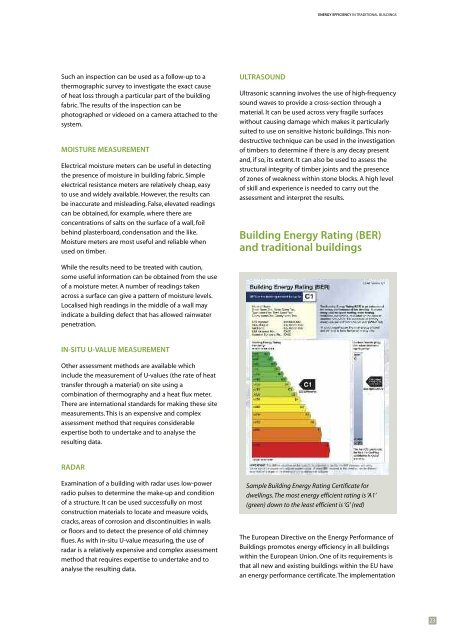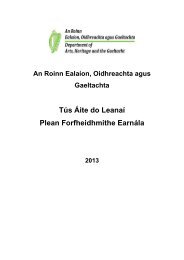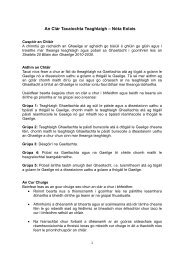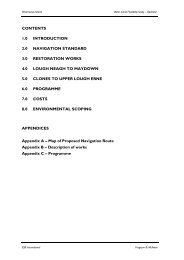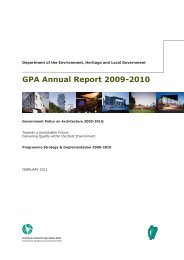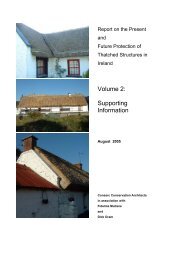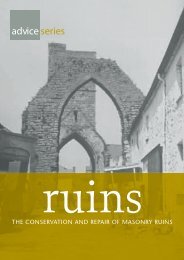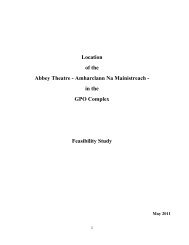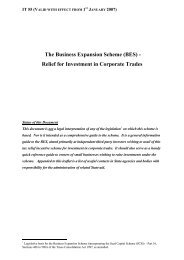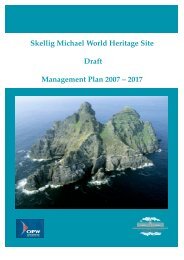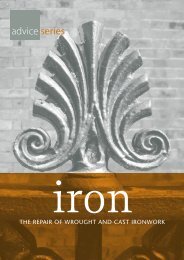Energy Efficiency in Traditional Buildings - Dublin City Council
Energy Efficiency in Traditional Buildings - Dublin City Council
Energy Efficiency in Traditional Buildings - Dublin City Council
You also want an ePaper? Increase the reach of your titles
YUMPU automatically turns print PDFs into web optimized ePapers that Google loves.
ENERGY EFFICIENCY IN TRADITIONAL BUILDINGS<br />
Such an <strong>in</strong>spection can be used as a follow-up to a<br />
thermographic survey to <strong>in</strong>vestigate the exact cause<br />
of heat loss through a particular part of the build<strong>in</strong>g<br />
fabric. The results of the <strong>in</strong>spection can be<br />
photographed or videoed on a camera attached to the<br />
system.<br />
MOISTURE MEASUREMENT<br />
Electrical moisture meters can be useful <strong>in</strong> detect<strong>in</strong>g<br />
the presence of moisture <strong>in</strong> build<strong>in</strong>g fabric. Simple<br />
electrical resistance meters are relatively cheap, easy<br />
to use and widely available. However, the results can<br />
be <strong>in</strong>accurate and mislead<strong>in</strong>g. False, elevated read<strong>in</strong>gs<br />
can be obta<strong>in</strong>ed, for example, where there are<br />
concentrations of salts on the surface of a wall, foil<br />
beh<strong>in</strong>d plasterboard, condensation and the like.<br />
Moisture meters are most useful and reliable when<br />
used on timber.<br />
ULTRASOUND<br />
Ultrasonic scann<strong>in</strong>g <strong>in</strong>volves the use of high-frequency<br />
sound waves to provide a cross-section through a<br />
material. It can be used across very fragile surfaces<br />
without caus<strong>in</strong>g damage which makes it particularly<br />
suited to use on sensitive historic build<strong>in</strong>gs. This nondestructive<br />
technique can be used <strong>in</strong> the <strong>in</strong>vestigation<br />
of timbers to determ<strong>in</strong>e if there is any decay present<br />
and, if so, its extent. It can also be used to assess the<br />
structural <strong>in</strong>tegrity of timber jo<strong>in</strong>ts and the presence<br />
of zones of weakness with<strong>in</strong> stone blocks. A high level<br />
of skill and experience is needed to carry out the<br />
assessment and <strong>in</strong>terpret the results.<br />
Build<strong>in</strong>g <strong>Energy</strong> Rat<strong>in</strong>g (BER)<br />
and traditional build<strong>in</strong>gs<br />
While the results need to be treated with caution,<br />
some useful <strong>in</strong>formation can be obta<strong>in</strong>ed from the use<br />
of a moisture meter. A number of read<strong>in</strong>gs taken<br />
across a surface can give a pattern of moisture levels.<br />
Localised high read<strong>in</strong>gs <strong>in</strong> the middle of a wall may<br />
<strong>in</strong>dicate a build<strong>in</strong>g defect that has allowed ra<strong>in</strong>water<br />
penetration.<br />
IN-SITU U-VALUE MEASUREMENT<br />
Other assessment methods are available which<br />
<strong>in</strong>clude the measurement of U-values (the rate of heat<br />
transfer through a material) on site us<strong>in</strong>g a<br />
comb<strong>in</strong>ation of thermography and a heat flux meter.<br />
There are <strong>in</strong>ternational standards for mak<strong>in</strong>g these site<br />
measurements. This is an expensive and complex<br />
assessment method that requires considerable<br />
expertise both to undertake and to analyse the<br />
result<strong>in</strong>g data.<br />
RADAR<br />
Exam<strong>in</strong>ation of a build<strong>in</strong>g with radar uses low-power<br />
radio pulses to determ<strong>in</strong>e the make-up and condition<br />
of a structure. It can be used successfully on most<br />
construction materials to locate and measure voids,<br />
cracks, areas of corrosion and discont<strong>in</strong>uities <strong>in</strong> walls<br />
or floors and to detect the presence of old chimney<br />
flues. As with <strong>in</strong>-situ U-value measur<strong>in</strong>g, the use of<br />
radar is a relatively expensive and complex assessment<br />
method that requires expertise to undertake and to<br />
analyse the result<strong>in</strong>g data.<br />
Sample Build<strong>in</strong>g <strong>Energy</strong> Rat<strong>in</strong>g Certificate for<br />
dwell<strong>in</strong>gs. The most energy efficient rat<strong>in</strong>g is ‘A1’<br />
(green) down to the least efficient is ‘G’ (red)<br />
The European Directive on the <strong>Energy</strong> Performance of<br />
Build<strong>in</strong>gs promotes energy efficiency <strong>in</strong> all build<strong>in</strong>gs<br />
with<strong>in</strong> the European Union. One of its requirements is<br />
that all new and exist<strong>in</strong>g build<strong>in</strong>gs with<strong>in</strong> the EU have<br />
an energy performance certificate. The implementation<br />
23


